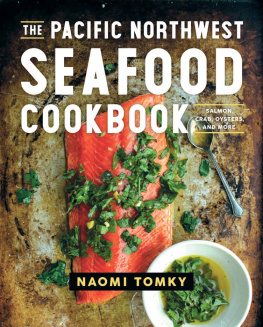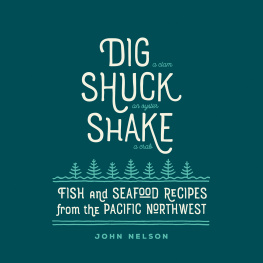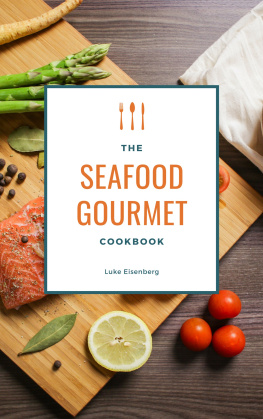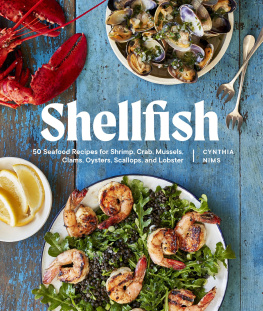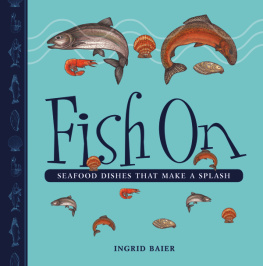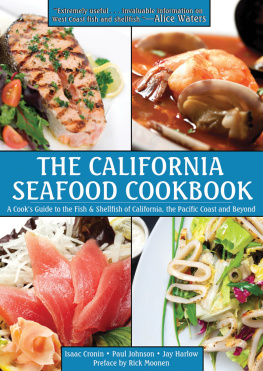THE PACIFIC NORTHWEST
SEAFOOD
COOKBOOK
SALMON, CRAB, OYSTERS, AND MORE
NAOMI TOMKY
PHOTOGRAPHY BY CELESTE NOCHE
THE COUNTRYMAN PRESS
A division of W. W. Norton & Company
Independent Publishers Since 1923
FOR BRETT, MY FAVORITE DISHWASHER, SEAFOOD-EATER, AND PERSON
CONTENTS
If you are going to follow links, please bookmark your page before linking.
An overhead look at oysters growing at Chelsea Farms in Olympia, Washington
G rowing up in Seattle, walking around Pike Place Market by age eight as if I owned it, and eventually becoming a food writernone of this translates directly to understanding or loving seafood. Though it seems that perfectly cooked salmon should be my birthright and I ought to have stirred chowder with my teething toys, the reality is that Seattles pristine seafood remains something of a mystery to many lifelong residents, as well as to newcomers and visitors.
In the 80s, salmon was often that stinky fish a friends uncle caught. Tossed on the grill until dry and stuck on like glue, it hardly inspired anyone to go out and pay good money for it. Still today, for many home cooks, that memory lingers: of mishandled or overcooked fish, improperly prepared oysters, or the unsolved mystery of how to cook a crab.
All of this adds up to an intimidating proposition: seafood, especially the high-quality goods of the Pacific Northwest, leans pricey. The fragile fish need to be cared for and cooked quickly after purchase. The margin of error is thinner for seafood than for a thick, resilient cut of meat, but the reward is also better. Perfectly cooked fish is sublime: bursting with clear saltwater flavor, tender, and rich with buttery fat.
Consider this book your roadmap to achieving that result: starting from that first panicked moment in the store, wondering if a piece of fish is even good. Does it deserve that price? How do you know its not past its prime? This book will hold your hand while you purchase the fish, help you keep it fresh at home, and then walk you through cooking it, from the first foolproof recipeslike the Slow-Roasted Salmon on .
Its a path that I traveled myself in the not-too-distant past. Despite growing up in the Pacific Northwest, aside from the occasional clam feast (as I mention in the Steamed Clams recipe on ), seafood wasnt an everyday part of my life. When I moved back to my beloved hometown of Seattle after college, though, I saw seafood through new eyes.
While making little money but many friends in the advertising department of a local newspaper, I started with a deep dive into happy hoursespecially the Seattle tradition of oyster happy hours. For as little as 25 cents apiece, we could slurp oysters as quickly as we could order them, wandering out into the night hours later, sated with the dozens downed.
Soon after this, I began working for a group of restaurants. My office sat above the kitchen of a seafood restaurant, where the smell of crab cakes frying often influenced my lunch decisions. There I met the late, great Jon Rowley, the citys guiding seafood spirit, as he brought the first Yukon River keta salmon to marketnot knowing Id later follow him through mushroom fields and across oyster flats to witness just a glimpse of his culinary expertise.
During a later job at a catering company, I stepped into the kitchen when staff was shorthanded, happily shucking, grilling, or frying oysters as needed, until I could do it quickly, expertly, and without gouging my hand with the oyster knife. I worked for a frozen seafood company, learning the mass-market side of the business: taste-testing year-old fish sticks to see how far into the future we could realistically claim they were best by, and then taking home mountains of deeply discounted product. Laying out a tablecloth of newspapers, Id text friends to come over with bread and wine and wed crack crab long into the evening, until our hands were slippery with butter, clumsily trying to pick the shell shards from the carpet.
By the time I became a full-time food writer, telling the stories of Seattles notable foods, best chefs, and most intriguing culinary stories, seafood had won my heart. I championed the citys shellfish in national magazines, flaunted the regions impeccable fish in guidebooks, and shared the stories of the people who catch and cook it wherever I could.
Because what I learned, through all the years of wide-eyed, open-mouthed observation, was that while we have access to an impressively grand spread of sustainable wild and farmed seafood here in the Pacific Northwest, we dont have widespread knowledge of how to cook it.
We go out to eat salmon and halibut, we regularly sidle up to oyster bars and slurp up mussels, but cooking seafood at home is a relatively rare event. This book tries to change that. It aims to bring the bounty of the Pacific Northwest not only into local home kitchens, but also into the kitchens of visitors who have tasted the local bounty and want to re-create those flavors at home. Which brings me to my final question in shaping the direction of this book and the types of recipes I wanted to include. Beyond the creatures from our local waters: what is Pacific Northwest seafood as a cuisine?
The Pacific Northwest I grew up inthe one where I still livethrives because of its people, which is exactly what I aim to capture in this cookbook. You will find a variety of recipes, from the historic and groundbreakinglike Shiro Kashibas black cod ().
What I learned during this process is that living in the Pacific Northwest makes you think about your food. From our forests to our coastlines and oceans, we are surrounded by lush abundance. From British Columbia down to Oregon, the combination of saltwater coastline, islands, rivers, and freshwater lakes, as well as mountains and old-growth forests, not only produces amazing seafood, but also calls on us to think a little bit harder about why and how we eat it.
The regions seafood, fish, and shellfish long sustained Indigenous peoples hunting and gathering along the coasts and inlets. Over decades of immigration, diverse cultures have come together to create a cuisine that is as varied as its inhabitants, yet still specific to this particular place.
Pacific Northwest cuisine means exceptional quality and thoughtful preparation. And, to be honest, a fair amount of fennel. It means inclusivityof ingredients, techniques, and traditions. Even ifno, especially ifthat means you dont have any experience with the food at all, we want you to join us at our table. This book is written to share the Pacific Northwest with everyone; to bring the PNW flavor home. To celebrate both the bounty of fresh seafood and the blending of culture and cuisine, through recipes ranging from traditional favorites to the interesting, unexpected, or international twists found in the region today.

